A Year in TV Guide explores the 1964-1965 television season through the pages of TV Guide magazine. Each week, I’ll examine the issue of TV Guide published exactly 50 years earlier. The intent is not simply to examine what was on television each week but rather what was being written about television.
Week #26
March 13th, 1965
Vol. 13, No. 11, Issue #624
Western New England Edition
On the Cover: Michael Landon, Lorne Greene, Dan Blocker, and Pernell Roberts (photograph by Gene Trindl).
The Magazine
With this issue, we’re into the second half of A Year in TV Guide, which has proven far more popular than I ever imagined. It is also taking far more time every week to put together than I original thought. My plan was to bank several reviews so I’d always be ahead three or four weeks but instead every week I’m scrambling to finish that week’s post by Friday morning. Still, it’s a lot of fun to dig through these old issues of TV Guide and I hope the last 25 are as interesting as the first 25.
This week’s cover article by Dwight Whitney, titled “The View from the Top,” is not about the cast of Bonanza but rather producer David Dortort. He is the only man in Hollywood who doesn’t worry when the important November Nielsen report is released because Bonanza regularly tops the charts. Dortort is also never bothered by the network. But it wasn’t always like this. His plans for Bonanza were not well-liked by NBC nor was his insistence on casting unknowns. Critics savaged the series and “show doctors” Martin Rackin and John Lee Mahin were hired to help out. Ratings suddenly shot up and Dortort spent the next four years regaining his independence.
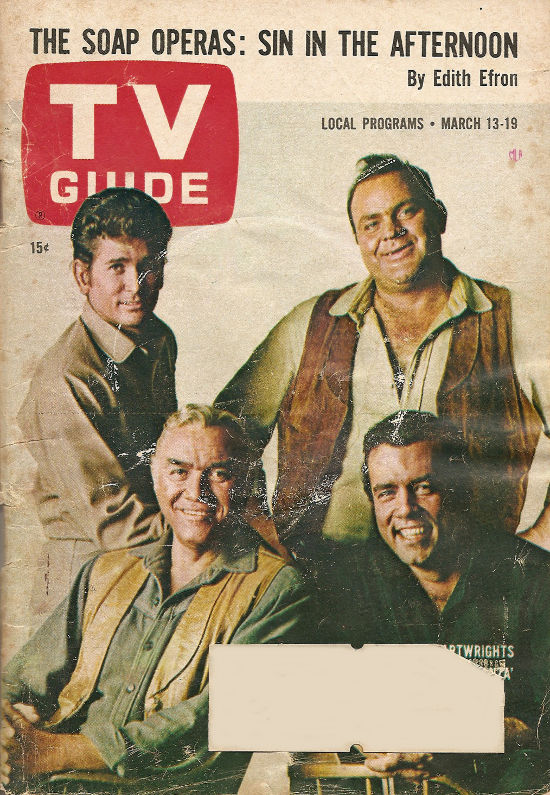
Front Cover – Copyright 1965 Triangle Publications, Inc.
The article was written around the time Pernell Roberts announced he was leaving Bonanza after six seasons. Said Dortort, “The problems, all his rudeness, his impossible conduct and lack of professionalism–I would forgive all that if he would come back. He is that good.” Yet he admits that he sometimes feels the same way Roberts does. Still, he doesn’t think leaving is the right thing to do:
About Pernell. I could understand him better if he were planning to stop being an actor. But he isn’t. One day I may go back to serious writing, myself. But I am a slum boy who sometimes feels he’s trying to be something he shouldn’t, and I have learned one thing: When fortune smiles, best not kick it in the teeth.
Edith Efron’s article “The Soaps–Anything but 99-44/100 Percent Pure” is far more academic than most TV Guide articles. At nearly six pages it is also longer than most articles. She examines whether the content of daytime soap operas reflects society, focusing on nine of the ten soap operas on the air. Only Edge of the Night was excluded from the study because it is not a soap opera but a serialized melodrama about a criminal lawyer. Two other daytime soap operas, Flame in the Wind and Moment of Truth, debuted after the analysis was started.
In the article, Efron states that there are three basis sources for dramatic tension and moral conflict on soap operas: mating, marriage, and babies. She gives multiple examples from the soap operas themselves and then quotes from producers and writers of soap operas who insist that they are only recognizing what is happening in society and writing about reality. Efron spoke with two psychologists who agreed to a degree. She also spoke with Betty Freidan, author of The Feminine Mystique, who insists that “the soaps are reflecting the sickest aspect of women.” One of the psychologists felt the same way, arguing that soap operas are “antifeminine” and reflect “the resistance of both writers and audience to the development of the total feminine personality.”
Freidan is the only one of the experts willing to pass judgement on soap operas:
The fact that immature, sick, dependent women exist in our society is no justification for these plays. The soap operas are playing to this sickness. They are feeding it. They are helping to keep women in this helpless, dependent state.”
“The Abbe Lane Story” is this issue’s profile of a celebrity and believe it or not I actually recognize the name although I will admit I thought she was an actress not a singer. The essay briefly covers her life and career as well as her ill-fated marriage to the much older Xavier Cugat. The two divorced in the spring of 1964 and she remarried in December of that year. Cugat has also found love again, an 18-year-old singer named Charo Baeza.
Marian Dern’s two-page article about Ronny and Clint Howard is a little dull. Dern was apprehensive before meeting the two young actors but soon realized they are just regular kids who collect baseball cards and like monster movies. Dern attempted to get 11-year-old Ronny to confirm that he coached his little brother, something a press agent had said, but it wasn’t true. When the conversation turned to baseball, 6-year-old Clint got really excited and the two had to be sent to the kitchen for apples. According to his parents, Ronny gets upset when all his friends go off to school and he has to go to work. He only gets to attend public school three months a year. Nobody treats them differently, although once some teenager girls ran the doorbell and were disappointed that Ronny’s father didn’t look like Andy Griffith.
Finally, there’s a one-page piece about The Big Picture, the syndicated series from the United States Army. It has been on the air since 1951 and in order to make it more interesting for viewers will soon introduce a series-within-a-series. Called The Army in Action, these 13 episodes will feature the Army’s “glory moments” from World War I through the present day. Norton S. Parker, chief of the Writers’ ranch of the Army Pictorial Center, thought up the series-within-a-series and had to prepare a 231-page treatment followed by scene-by-scene descriptions of every shot. He began working on it in 1962 but production didn’t actually start on the episodes until February 1964. The episodes began airing in January 1965 on around 350 stations and 40 military posts overseas.
The “As We See It” editorial worries about the impact of an FCC proposal that would allow the networks to own no less than half of the programs they air between 6PM and 11PM, effectively forcing them to air shows brought to them by advertisers. TV Guide is concerned that the proposal would give advertisers even more power than they already have, which is worse than the networks controlling programming.
Cleveland Amory’s reviews return with this issue, after a lengthy absence while Amory was off judging the International Television Festival in Monaco. His review of World War I on CBS is very positive. He praises co-producers John Sharnick and Isaac Kleinerman, who spent two years working on the series before it premiered, sourcing footage never before seen on television. He calls the music by Morton Gould “truly magnificent” while Robert Ryan’s narration is said to be excellent.
News from the Hollywood and New York TV Teletype columns:
- Actor Marshall Thompson is traveling to Africa next month with a production crew to film location scenes for Clarence the Cross-Eyed Lion, an upcoming CBS series produced by Ivan Tors. [Daktari premiered until January 1966.]
- Lucille Ball will return to CBS next season for $90,000 an episode, the highest priced paid by any network for a half-hour series.
- Spencer Tracy will serve as narrator for The Red, White and Blue, a series of specials from David Wolper Productions exploring American history and traditions. The first will air on Columbus Day, the second on Election Day.
- Albert Salmi is leaving Daniel Boone, disappointed with the size of his role on the series.
- Universal is planning a new daytime game show called Quick as a Wink, hosted by Dave Hull. [I don’t believe it ever materialized.]
- ABC has renewed The Flintstones for a sixth season.
- Terence Young hopes to cast Kim Novak, Claudia Cardinale, Jeanne Moreau, Vittorio de Sica, Alec Guinness, Paul newman, Joanne Woodward, Sidney Poitier, and Richard Widmark in his upcoming United Nations drama sponsored by Xerox. It will be written by Ian Fleming and deal with the international narcotics trade. [“The Poppy Is Also a Flower” aired in October 1966.]
- Brian Epstein, manager of The Beatles, has another protege in the form of singer Cilla Black, who’ll appear in the April 4th episode of The Ed Sullivan Show.
- Rod Amateau will produce and direct a movie based on Shindig, set for release during the summer. [Was this ever produced? I don’t believe so.]
Rounding out the national section this week is a picture feature depicting Walter Brennan being turned into a statue for an episode of The Tycoon. There is also the regular TV crossword puzzle.
There were three news reports in the “For the Record” column in the listings section this week, two having to do with James T. Aubrey, Jr. being ousted as CBS-TV president:
- New CBS-TV president John A. Schneider discovered after just two days on the job that it isn’t going to be easy replacing Aubrey. The CBS press department decided to set up a small meeting with a handful of TV critics in New York City to meet Schneider. Word got out and about 40 people showed up, turning what should have been a low-key meet-and-greet into a full-blown press conference (an NBC reporter, Joseph Michaels, was asked to leave). Schneider was as general as possible in his answers and told those gathered “I hope the first 36 hours in this job aren’t typical. It’s the hard way to lose weight. It’s going to be quicker than an all-protein diet.”
- The regime change at CBS means changes to the network’s 1965-1966 schedule: Selena Mead is out, in favor of Hazel, which the network acquired from NBC; Rawhide and Password, which Aubrey ruled out, may return; Aubrey’s “Clarence the Cross-Eyed Lion” will likely be dropped; the network’s new prime time serial [Our Private World], a spin-off of As the World Turns, probably won’t return in the fall.
- Former White House press secretary James C. Hagerty, vice president in charge of corporate relations for American Broadcasting-Paramount Theatres, Inc., opposes the over-use of bulletins that interrupt regular programming. He urged broadcasters to use common sense to avoid the “airing of indiscriminate and rather minor bulletins just for the sake of being first, without regard to worth. This is especially true in the explosive Vietnam crisis or any other crisis so as not to create false impressions in the public mind.”
The letters page includes a lengthy rebuttal from Bob Crane in response to Marian Dern’s February 27th article about him:
Many thanks to Marian Dern for the fine article “Man in Pursuit of Himself;” however, I would like to correct some quotes attributed to Donna Reed’s husband, producer Tony Owen. I was not dropped from The Donna Reed Show because of a demand for more money, but had already informed Tony Owen last August I would be leaving at the end of the current season. Donna did say they had always wanted a next-door neighbor during the first five years of the show and finally found one in me. I had already filmed two episodes before they hired Ann McCrea to play my wife. Finally, I am not “begging to be back” next year as my new CBS series, Hogan’s Heroes, starts in the fall, Friday nights at 8:30, and will keep me quite busy.
Bob Crane
Los Angeles
This letter is more proof that TV Guide was once a very important publication for those in the television industry, although it’s debatable whether Crane was hoping to reach industry insiders or viewers (or perhaps both) with his letter.
There were also two letters from young housewives responding to the February 27th “As We See It” editorial about the popularity of comedies on television:
Re your Feb. 27 “As We See It” noting that “comedies apparently appeal to young married housewives…” Here’s a sad young housewife who is sorry to see that most of the “funny comedies” on this year’s bill of fare will not only continue next season but actually increase in number.
Carol Ragozzine
Girard, OhioBeing one of those young married housewives, I was outraged by the implication that we are to blame for the sorry state of TV programming.
Beatrice Rasum
North Massapequa, N.Y.
Other letters included two about the February 27th profile of Mae West (one supportive and one critical), a letter praising The King Family, and one suggesting a new TV series called The Nielsen Family (it “can’t miss”).
The TV Listings
There were a number of specials this week. ABC aired its second David L. Wolper documentary about “the extraordinary men of our time” on Saturday, March 13th from 7:30-8:30PM. “The Bold Men” featured skydiver Rod Pack, adventurer John Craig, construction worker Don Wilson, diver Carlos Roman, firefighter Red Adair, and others. Here’s an advertisement:
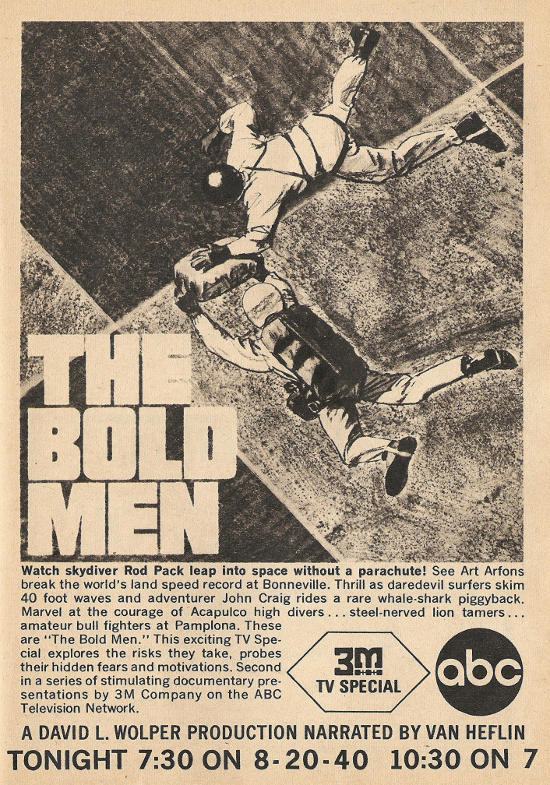
Advertisement for The Bold Men on ABC – Copyright 1965 Triangle Publications, Inc.
The first documentary in the series, “The Way-Out Men,” was broadcast on February 13th. Both were sponsored by 3M.
On Sunday, March 14th ABC aired the second of four “Alcoa Preview” specials from 7:30-8:30PM with host Douglas Fairbanks. It included a behind-the-scenes look at Brigitte Bardot’s new movie Viva Maria, Tommy Steele preparing for his Broadway debut in Half a Sixpence, and a profile of actress Virna Lisi. That same night NBC aired a Danny Thomas special from 9-10PM titled “The Wonderful World of Burlesque” with guests Mickey Rooney, Jim Nabors, and Lee Remick. A picture feature in the March 6th issue explored Remick’s scandalous striptease sketch from the special.
CBS aired an hour-long CBS News Special about Vice President Hubert Humphrey from 10-11PM on Monday, March 15th. Harry Reasoner and Roger Mudd interviewed Humphrey, focusing on his personality and his opinions on what the vice presidency is and should be. Dinah Shore’s final special of the season aired on Wednesday, March 17th from 8:30-9:30PM on ABC. Bob Hope joined Dinah for the special, which was taped at the Los Angeles Music Center Pavilion.
On Thursday, March 18th, ABC aired an hour-long special called “Man Invades the Sea” with Jacques-Yves Cousteau about the pioneers of deep ocean exploration Robert Montgomery narrated. NBC broadcast the America’s Junior Miss Pageant on Friday, March 19th from the Municipal Auditorium in Mobile, Alabama. Portions of the hour-long telecast were live while others were pre-taped.
The weekend, of course, was filled with sports. NBC aired the first game of the National Invitation Tournament at 3PM on Saturday, March 13th. The basketball game pitted the St. Louis Billikens against the West Point Cadets. Jim Simpsons and George Mikan called the game. At 3:30PM, ABC aired the live finals and semifinals of the Wisconsin Open, part of the pro bowlers tour, from Madison. On ABC’s World of Sports at 5PM, the schedule called for the National Tourist Trophy Championship Motorcycle Race and the International Tobogganing Championship.
On Sunday, CBS Sports Spectacular at 2:30PM featured the Florida State University Circus and a review of horse racing. And NBC Sports in Action included five speed skating races taped in January, the Carnival’s parade with Vice President Hubert Humphrey, and a profile of coach Red Auerbach.
Here are the TV Guide close-ups for the week:
- NIT Basketball (NBC, Saturday at 3:00PM)
- Special: The Bold Men (ABC, Saturday at 7:30PM)
- Special: Danny Thomas – “The Wonderful World of Burlesque” (NBC, Monday at 9:00PM)
- Special: Man Invades the Sea (ABC, Thursday at 10:00PM)
Here are some of the programs available for purchase by subscribers to Zenith Radio Company’s Phonevision pay television experiment on Connecticut’s WHCT-TV (Channel 18):
- Movie: The Brass Bottle (Saturday at 1:00PM, $0.55)
- Movie: Father Goose (Saturday at 6:30PM, $1.50)
- Pro Hockey: Detroit Red Wings vs. Boston Bruins (Sunday at 7:30PM, $1.25)
- Concert: Mozart in Munich (Monday at 9:00PM, $1.50)
- Movie: Two on a Guillotine (Tuesday at 8:30PM, $1.25)
- Movie: Psyche 59 (Wednesday at 8:30PM, $1.00)
- Movie: Quick! Before It Melts (Thursday at 7:00PM, $1.25)
- Movie: A Boy Ten Feet Tall (Friday at 7:00PM, $1.25)
And just because I think it looks neat, here’s an advertisement for the Thursday, March 18th episode of NBC’s Kraft Suspense Theatre (“Won’t It Ever Be Morning?” with John Cassavetes, Gena Rowlands, and Jack Klugman):
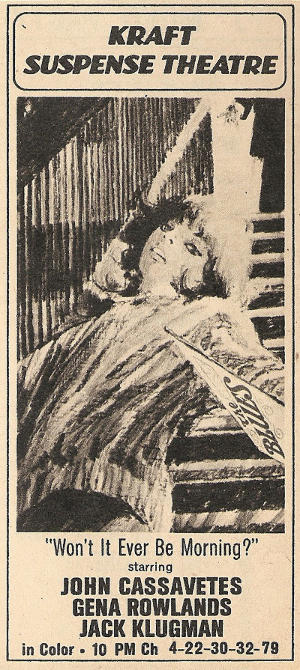
Advertisement for Kraft Suspense Theatre on NBC – Copyright 1965 Triangle Publications, Inc.
Locally, it was a relatively normal week. WWLP (Channel 22) and WRLP (Channel 32) broadcast live high school basketball (the Western Massachusetts Schoolboy Basketball Tournament, to be exact) at 9PM on Saturday, pre-empting NBC Saturday Night at the Movies. WTIC-TV (Channel 3) premiered a syndicated series called Some Heroical Spirits on Sunday, March 14th at 9:30AM. WNHC-TV (Channel 8) aired a half-hour of Irish songs from 9:30-10AM featuring the St. Mary’s High School Chorus. WTIC-TV’s From the College Campus aired from Trinity College in Hartford, CT from 11:30AM-12PM.
A public affairs report titled “The Impossible Takes a Little Longer: Traffic Law Enforcement” aired on WHDH-TV (Channel 5) from 12-12:30PM on Sunday. WBZ-TV (Channel 4) broadcast a half-hour documentary called “Children Without” from 4-4:30PM.
WWLP and WRLP aired its own public affairs panel from 4-5PM. The topic for the live broadcast was “Is Public Power in the Public Interest?” And WNHC-TV aired the final holes of the Doral Open (golf) at 5PM.
Last week WHYN-TV ran a very nice advertisement for its sci-fi movie block The 40th Dimension. This week comes an advertisement for its two boxing programs: five-minute Knock-Out! (weeknights at 5:55PM) and Greatest Fights of the Century (Saturdays from 10:30-11PM):
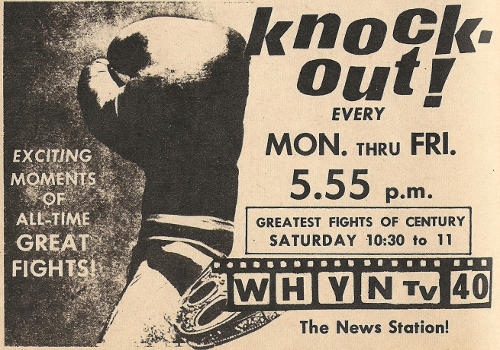
Advertisement for Knock-Out! on WHYN-TV (Channel 40) – Copyright 1965 Triangle Publications, Inc.
Here are the episode descriptions for Dateline Boston, a local series broadcast live and in color Monday through Friday from 6-6:25PM on WHDH-TV (Channel 5):
Monday, March 15th, 1965
Captain Bob demonstrates means to achieve sharp color and depth in art.Tuesday, March 16th, 1965
Hints are given for filing this year’s income tax. Howard Green is moderator.Wednesday, March 17th, 1965
Singers and dancers from Ireland perform in honor of St. Patrick’s Day.Thursday, March 18th, 1965
Maj. Gen. Leigh Wade discusses the first circumnavigation of the globe by air.Friday, March 19th, 1965
High school students participate in a chemistry quiz. Fran Mear, Wellesley High School, is quizmaster.
That’s it for this week. Hit the comments with your thoughts.

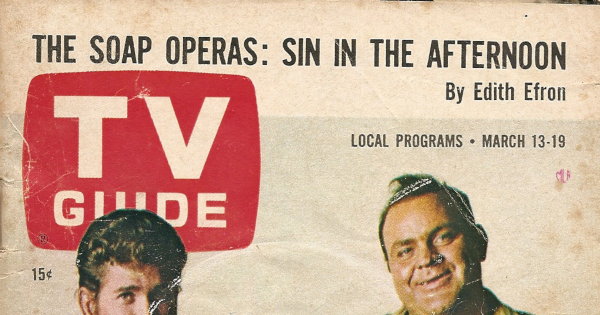
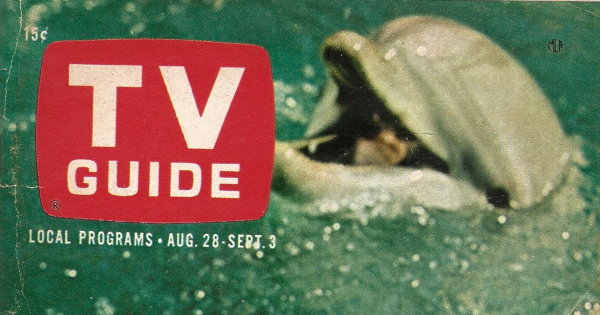
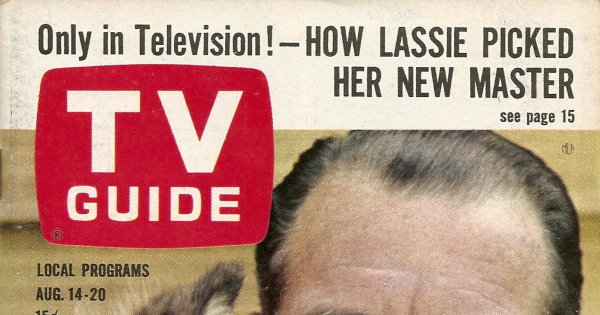
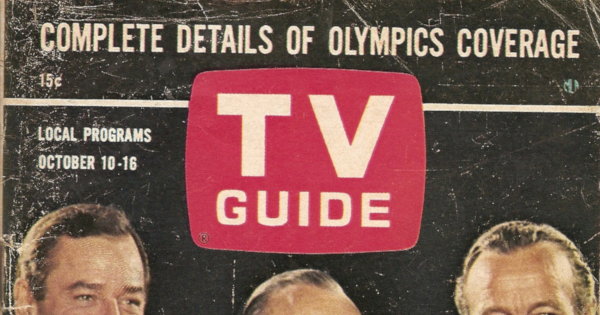



“Rounding out the national section this week is a picture feature depicting Walter Brennan being turned into a statue for an episode of The Tycoon”.
There’s a full color spread of “The Tycoon” located in EXHIBITS (at the top of page) under TV Guide – Behind the Scenes of the 1964-1965 Season.
Lucy made in 1965 in one season what would amount to $17 Million dollars in 2015. I wonder how much of that got plowed right back into Desilu though.
I think that Dortort’s comment about Roberts gave TV Guide the name for a profile of Roberts when he was later starring in “Trapper John, MD”: “When Lady Luck Smiled, He Kicked Her in the Teeth”. Around 1966, Roberts made a guest appearance on “Gunsmoke” as a villain. Did he think that “Gunsmoke” was that much better than “Bonanza”, I wonder.
From your mention of “The Big Picture”, should that be January 1965 [not January 19645] when the episodes began airing?
Thanks for creating this every week. I look forward to reading it every Friday.
By this time, Dave Dortort was executive producer of the series, with Richard Collins as producer-at lease i believe that would be the case beginning in the 65-66 season. I watched quite a bit of Bonanza. The show currently airs on both MeTV and TV Land. Many of the episodes can be found on DVD, including the official first few seasons from Paramount Home Video/CBS Video. The show had always been filmed at Paramount studios, not once did i see the name Desilu during the closing credits on Bonanza.
Also interesting is the fact that break-in record master Dickie Goodman released a parody 50 years ago called “Scmonanza”-i found it on YouTube last week. Here’s the link: https://www.youtube.com/watch?v=HFGWog2qvI8
Bonanza was a wholly-owned NBC Production; they rented space at Paramount for filming.
Paramount didn’t buy Desilu until the late ’60s, maybe ten years after Bonanza started. When that sale took place, NBC continued to rent as they had before.
All this predated NBC’s relationship with MCA/Universal; Had Bonanza began ten years later than it did, it might have filmed at Universal instead.
As to why Paramount/CBS has the video rights –
-your guess is as good as mine.
Yes, The Big Picture started in January 1965. “19645” is one of the more bizarre mistakes I have made.
Because NBC Films’ inventory of pre-1971 programs- the ones the network either produced or owned- were “spun off” to National Telefilm Associates, as broadcast networks weren’t allowed to own AND distribute their own programming after 1971 {“CBS Films” became the independent “VIACOM”, while “ABC Films” evolved into “Worldvision”}. However, due to various mergers over the years, CBS wound up with the PHYSICAL rights to “BONANZA”, while NBC owns the rights to the series.
How fortunate was WHYN-TV (now WGGB) to be the Pioneer Valley’s ABC station as they are now? 50 years ago, the first appearance on “Wide World of Sports” of boxing champ Muhammad Ali (still known as Cassius Clay) with ABC’s Howard Cosell was that era’s version of “Must-See TV”. In January 1965, when Ali appeared to look at highlights of his second bout with Sonny Liston, it must have galvanized many viewers in that part of Massachusetts. Many called that fight a fix because of Ali’s famous “Phantom Punch”.
Having both “Wide World” and “Pro Bowlers’ Tour” on the Saturday afternoon schedule meant ABC stations had captive audiences. I kinda miss those days, when i’d get to see and hear the likes of Jim McKay, Chris Schenkel and the like doin’ their thing.
Incidentally, “Daktari” debuted on CBS in January 1966, not September, that was the start of its’ SECOND year. And i was lucky enough to have been around during its’ run as well as for reruns.
WWLP’s other satellite station, WJZB channel 14 is listed in the Eastern New England edition of the mag. It would go dark for good in 1969. It was located in Worcester, which is part of the Boston Market. And with an NBC station there (WBZ channel 4), this station was an independent, yet still carrying some WWLP shows.
Jack Klugman’s career took an upswing in the mid 70’s. After “The Odd Couple” ended, he returned to Universal Studios to play Quincy in 1976. He would become famous for that part into the 80’s.
Danny Thomas had a sitcom on NBC called “The Practice”, which also premiered in ’76. It lasted until ’77.
Had no idea Bob Crane was Donna Reed’s next door neighbor on her show. The only other sitcom appearance i recall was his guesting on “The Dick Van Dyke Show”. He appeared as a panelist on “What’s My Line?” when the To Tell the Truth panel were mystery guests in December 1966.
One minor correction: DAKTARI actually premiered in January 1966 instead of September that year. Like BATMAN, it was an immediate mid-season smash, and actually had more staying power than ABC’s surprise hit, finishing 14th in that truncated 1965-66 season and rising to 7th in 1966-67, DAKTARI did burn out after that and was gone in January 1969
Thanks for the correction. I cannot remember now what source I referenced but I must have misread it.
“Won’t It Ever Be Morning?” was actually a pilot for a possible series, with John Cassavetes as a private eye. But the artwork is misleading—it looks like 1965, and the show was set in 1948.